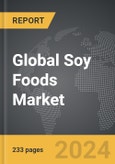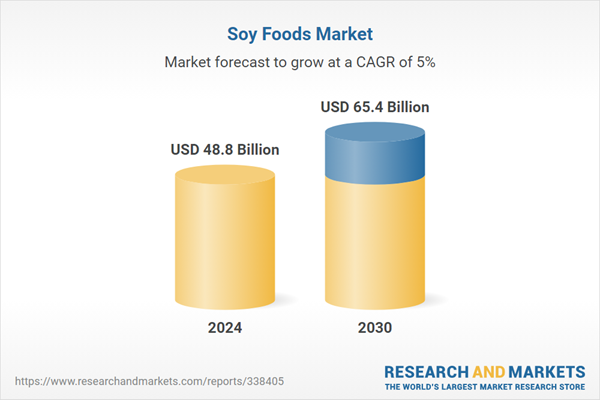Global Soy Foods Market - Key Trends and Drivers Summarized
Soybeans: The Magic Bean Powering Health and Sustainability
Soybeans are often hailed as the 'magic bean' due to their incredible versatility and substantial health benefits. Rich in protein, soybeans serve as a critical source of nutrition, particularly in vegetarian and vegan diets, where they provide essential amino acids typically found in meats. Beyond nutrition, soybeans are remarkably adaptable in food production; they can be processed into a myriad of products including tofu, tempeh, soy milk, and soy sauce, catering to diverse culinary traditions and dietary preferences. Soy also contains isoflavones, compounds that have been linked to reduced risks of heart disease, osteoporosis, and certain forms of cancer, especially hormone-related cancers such as breast cancer. Additionally, soybeans play a significant role in sustainable agriculture as they fix nitrogen in the soil, reducing the need for chemical fertilizers and improving soil fertility. This multifunctional bean supports not only human health but also environmental health, earning its title as a truly 'magic' bean.What Makes Soy Foods a Growing Staple in Global Diets?
It is therefore of little surprise that soy foods have become a pivotal component of the global diet, valued for their nutritional benefits and versatility in various culinary applications. Originating from East Asia, soybeans are processed into a myriad of products including tofu, tempeh, soy milk, and soy sauce, each offering unique flavors and health benefits. Rich in protein, vitamins, and minerals, soy foods are often celebrated as a staple in vegetarian and vegan diets due to their high-quality protein content that is comparable to that found in animal products. Additionally, soy foods contain isoflavones, a class of phytoestrogens that have been studied for their role in reducing the risk of heart disease and certain cancers. Their global popularity can be attributed not only to their health benefits but also to their cultural importance in various cuisines, making them a versatile ingredient favored by consumers around the world.How Are Innovations Influencing Soy Food Production and Consumption?
The soy food industry has seen significant innovations that enhance the appeal and nutritional value of soy-based products. Advances in food technology have enabled manufacturers to improve the taste and texture of soy foods, making them more palatable to a wider audience. For instance, techniques such as fermentation are used to develop tempeh and certain types of soy sauces, which are prized for their rich flavors and health benefits, such as improved digestibility and enhanced nutrient absorption. Moreover, genetic modifications and breeding techniques have led to the cultivation of soybeans that yield higher protein content, better oil profiles, and reduced levels of undesirable components like phytates and allergens. These advancements not only cater to the nutritional preferences of health-conscious consumers but also improve the sustainability of soy food production by increasing yield and reducing the need for chemical inputs.What Trends Are Driving the Popularity of Soy Foods Among Consumers?
The rising popularity of soy foods can be attributed to several key trends. The shift towards plant-based diets, driven by health, environmental, and ethical considerations, has particularly bolstered the demand for soy-based products as meat and dairy alternatives. Soy foods are integral to this movement, providing essential proteins and nutrients that might otherwise be difficult to obtain from a purely plant-based diet. Furthermore, the increasing incidence of lactose intolerance and the growing vegan population have spurred the demand for soy milk and other soy-based dairy alternatives. Additionally, the global fusion of culinary cultures has introduced soy foods to new demographics, who are eager to explore diverse dietary options. These trends are supported by a growing body of scientific research that touts the health benefits of soy, influencing consumer preferences and driving market growth.What Drives the Growth in the Soy Foods Market?
The growth in the soy foods market is driven by several factors, including increased awareness of the health benefits associated with soy consumption, such as cholesterol reduction and potential cancer risk reduction. The expanding global vegetarian and vegan population, who often turn to soy foods as a primary protein source, also significantly contributes to this demand. Technological advancements in food processing have made it possible to enhance the flavor and texture of soy products, increasing their acceptance among mainstream consumers who might not otherwise consider soy as an alternative to meat or dairy products. Additionally, environmental concerns regarding the sustainability of traditional animal farming have prompted consumers to seek out more eco-friendly alternatives like soy, which generally requires fewer resources to produce than animal products. Finally, government initiatives promoting soy cultivation and consumption as part of national health and agricultural policies further stimulate market growth, securing soy foods' position as a key component of the global food landscape.Report Scope
The report analyzes the Soy Foods market, presented in terms of market value (USD). The analysis covers the key segments and geographic regions outlined below.- Segments: Product (Milk, Oil, Other Products); Application (Food & Beverages, Feed, Other Applications).
- Geographic Regions/Countries: World; United States; Canada; Japan; China; Europe (France; Germany; Italy; United Kingdom; Spain; Russia; and Rest of Europe); Asia-Pacific (Australia; India; South Korea; and Rest of Asia-Pacific); Latin America (Argentina; Brazil; Mexico; and Rest of Latin America); Middle East (Iran; Israel; Saudi Arabia; United Arab Emirates; and Rest of Middle East); and Africa.
Key Insights:
- Market Growth: Understand the significant growth trajectory of the Soy Milk segment, which is expected to reach US$34.3 Billion by 2030 with a CAGR of 5.6%. The Soy Oil segment is also set to grow at 4.5% CAGR over the analysis period.
- Regional Analysis: Gain insights into the U.S. market, valued at $13 Billion in 2024, and China, forecasted to grow at an impressive 8.4% CAGR to reach $14.3 Billion by 2030. Discover growth trends in other key regions, including Japan, Canada, Germany, and the Asia-Pacific.
Why You Should Buy This Report:
- Detailed Market Analysis: Access a thorough analysis of the Global Soy Foods Market, covering all major geographic regions and market segments.
- Competitive Insights: Get an overview of the competitive landscape, including the market presence of major players across different geographies.
- Future Trends and Drivers: Understand the key trends and drivers shaping the future of the Global Soy Foods Market.
- Actionable Insights: Benefit from actionable insights that can help you identify new revenue opportunities and make strategic business decisions.
Key Questions Answered:
- How is the Global Soy Foods Market expected to evolve by 2030?
- What are the main drivers and restraints affecting the market?
- Which market segments will grow the most over the forecast period?
- How will market shares for different regions and segments change by 2030?
- Who are the leading players in the market, and what are their prospects?
Report Features:
- Comprehensive Market Data: Independent analysis of annual sales and market forecasts in US$ Million from 2024 to 2030.
- In-Depth Regional Analysis: Detailed insights into key markets, including the U.S., China, Japan, Canada, Europe, Asia-Pacific, Latin America, Middle East, and Africa.
- Company Profiles: Coverage of players such as Adisoy Foods & Beverages Pvt. Ltd., Archer Daniels Midland Company, Caramuru Group, Cargill, Inc., Eden Foods, Inc. and more.
- Complimentary Updates: Receive free report updates for one year to keep you informed of the latest market developments.
Some of the 138 companies featured in this Soy Foods market report include:
- Adisoy Foods & Beverages Pvt. Ltd.
- Archer Daniels Midland Company
- Caramuru Group
- Cargill, Inc.
- Eden Foods, Inc.
- Miracle Soybean Food International Corporation
- Nordic Soya Oy
- Northern Soy
- The Hain Celestial Group, Inc.
- Victoria Group A.D.
This edition integrates the latest global trade and economic shifts into comprehensive market analysis. Key updates include:
- Tariff and Trade Impact: Insights into global tariff negotiations across 180+ countries, with analysis of supply chain turbulence, sourcing disruptions, and geographic realignment. Special focus on 2025 as a pivotal year for trade tensions, including updated perspectives on the Trump-era tariffs.
- Adjusted Forecasts and Analytics: Revised global and regional market forecasts through 2030, incorporating tariff effects, economic uncertainty, and structural changes in globalization. Includes historical analysis from 2015 to 2023.
- Strategic Market Dynamics: Evaluation of revised market prospects, regional outlooks, and key economic indicators such as population and urbanization trends.
- Innovation & Technology Trends: Latest developments in product and process innovation, emerging technologies, and key industry drivers shaping the competitive landscape.
- Competitive Intelligence: Updated global market share estimates for 2025, competitive positioning of major players (Strong/Active/Niche/Trivial), and refined focus on leading global brands and core players.
- Expert Insight & Commentary: Strategic analysis from economists, trade experts, and domain specialists to contextualize market shifts and identify emerging opportunities.
Table of Contents
Companies Mentioned (Partial List)
A selection of companies mentioned in this report includes, but is not limited to:
- Adisoy Foods & Beverages Pvt. Ltd.
- Archer Daniels Midland Company
- Caramuru Group
- Cargill, Inc.
- Eden Foods, Inc.
- Miracle Soybean Food International Corporation
- Nordic Soya Oy
- Northern Soy
- The Hain Celestial Group, Inc.
- Victoria Group A.D.
Table Information
| Report Attribute | Details |
|---|---|
| No. of Pages | 233 |
| Published | December 2025 |
| Forecast Period | 2024 - 2030 |
| Estimated Market Value ( USD | $ 48.8 Billion |
| Forecasted Market Value ( USD | $ 65.4 Billion |
| Compound Annual Growth Rate | 5.0% |
| Regions Covered | Global |









